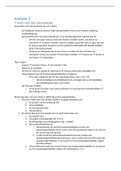Samenvatting
Summary ALL articles for Brand Management
- Vak
- Brand Management
- Instelling
- Vrije Universiteit Amsterdam (VU)
ALL articles for the course Brand Management summarized, ready for you to rock your exam :) Have a look at the other documents I uploaded!
[Meer zien]








